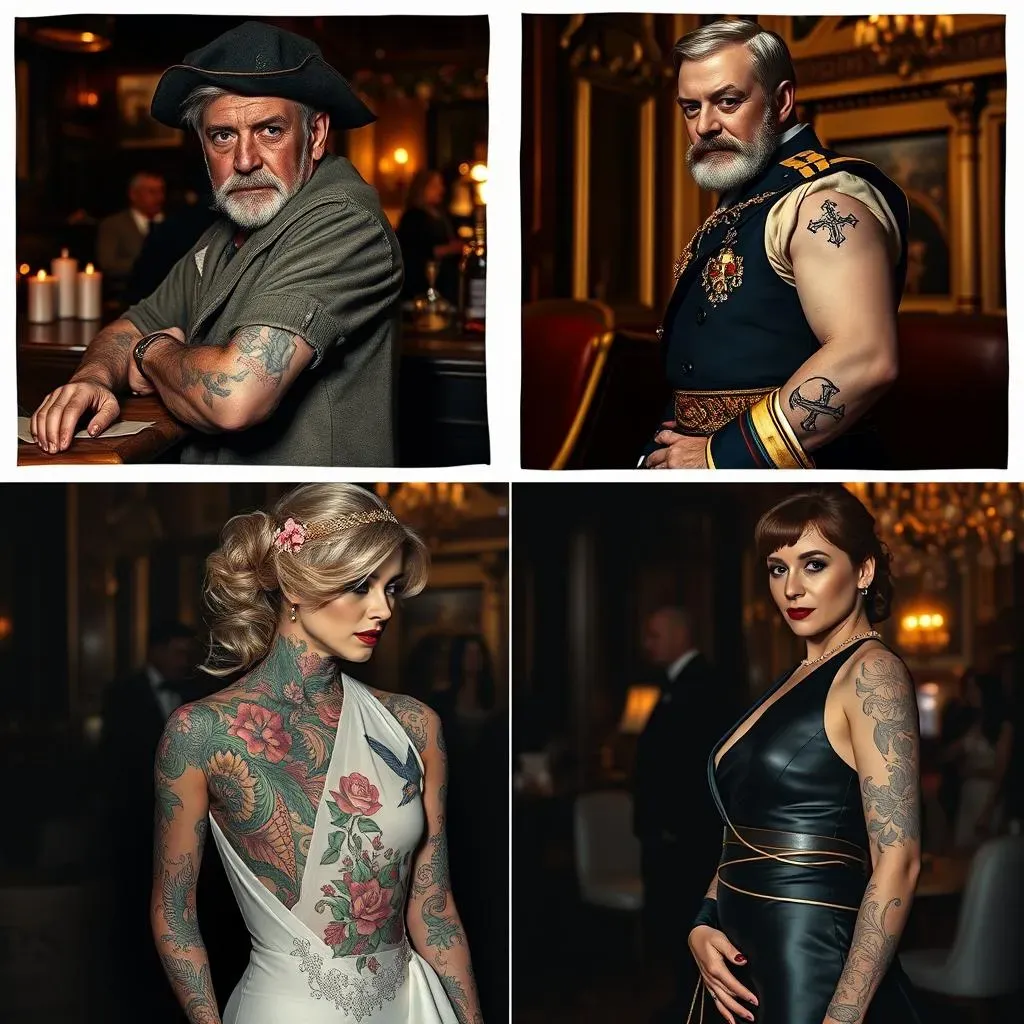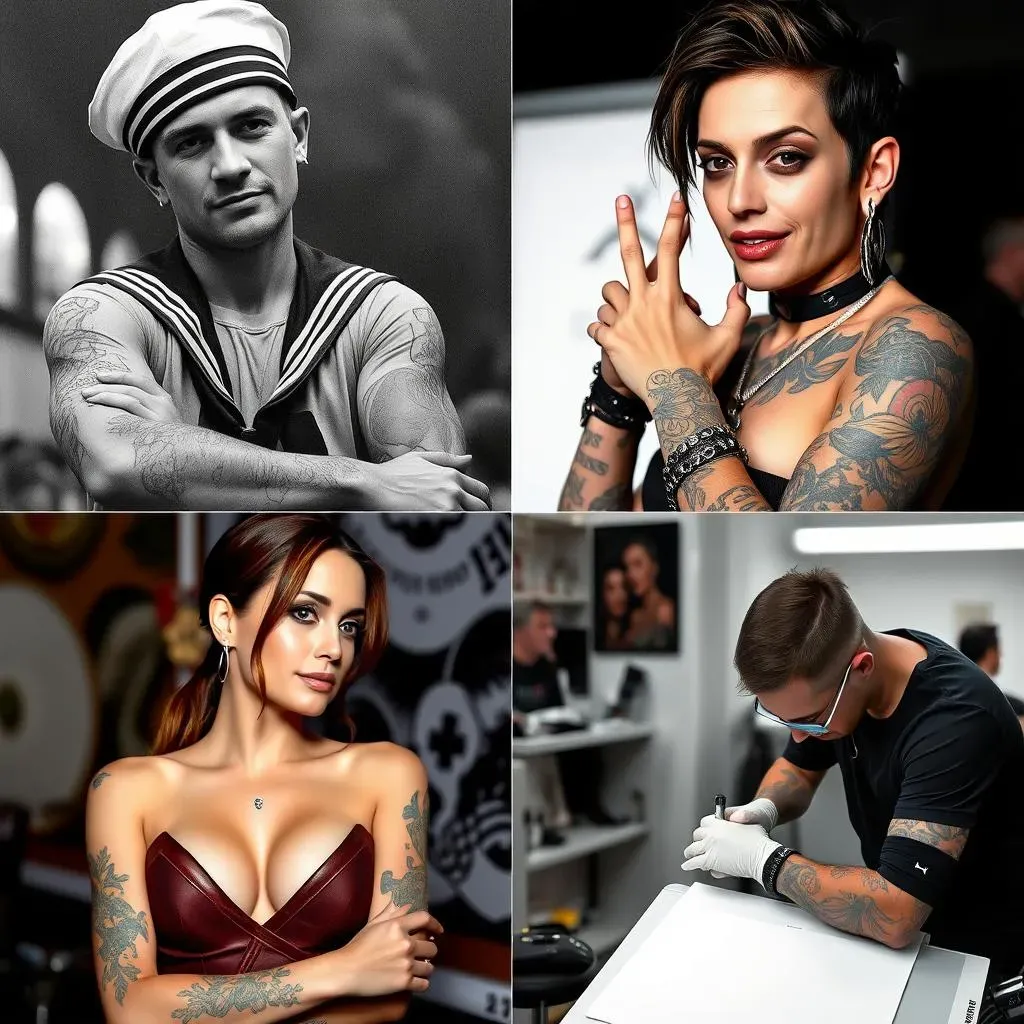Table of Contents
Tattoos! They're everywhere these days, right? From celebrities flaunting intricate sleeves to your neighbor sporting a subtle wrist design, it seems like everyone's getting inked. But when did tattoos become fashionable, exactly? It's not like people just woke up one morning and decided to start permanently decorating their bodies. The journey from ancient ritual to modern trend is a long and winding one, filled with sailors, social rebels, and a surprising amount of high society. Ready to find out when tattoos became fashionable? We're going way back, exploring ancient civilizations and the marks they left on their skin. Then, we'll chart the course of tattoos through Western history, from the fringes of society to the mainstream. Finally, we'll look at how tattoos have evolved into the ultimate fashion statement they are today. So, buckle up and get ready to discover the fascinating story of ink and skin!
Ancient Origins: The Early History of Tattoos
Ancient Origins: The Early History of Tattoos
The Iceman's Ink: Ötzi's Ancient Tattoos
Forget what you think you know about tattoos being a modern thing. We're talking seriously old school here. The earliest evidence points us to Ötzi the Iceman, a mummy discovered in the Alps, dating back to between 3370 and 3100 BCE. This dude wasn't just rocking a loincloth; he had tattoos! Around 61 of them, to be exact.
These weren't just random doodles, either. Scientists believe they might have been therapeutic, placed on areas of his body that showed signs of wear and tear. Talk about ancient medicine meets body art!
Ötzi's Tattoo Details
- Age: Over 5,000 years old
- Location: Found on the body of Ötzi the Iceman in the Alps
- Number of Tattoos: Approximately 61
- Possible Purpose: Therapeutic, aligned with acupuncture points
Global Ink: Tattoos Across Ancient Cultures
Ötzi isn't the only ancient example. Tattooing was a global phenomenon. Ancient Egypt, Africa, Asia, the Americas – you name it, they were probably inking. The techniques and designs varied widely, from simple dots and lines to intricate patterns and symbols. Each culture had its own reasons for tattooing, ranging from religious and spiritual beliefs to marking status and identity.
In some cultures, tattoos were a rite of passage, marking the transition from childhood to adulthood. In others, they were a sign of courage or skill, earned through battles or hunts. And let's not forget the purely decorative aspect – because sometimes, people just want to look cool!
Barbaric or Beautiful? Ancient Attitudes Toward Tattoos
Not everyone was a fan of tattoos, though. In ancient China, for example, tattoos were initially seen as barbaric, associated with the Yue peoples. However, things got a little more complicated later on. During certain periods, tattoos became fashionable among the upper classes. Go figure!
Meanwhile, in Japan, tattooing has a long and rich history, dating back to the Jōmon period. Influenced by Chinese and Korean culture, Japanese tattoos evolved into elaborate and artistic masterpieces. So, while some cultures might have frowned upon ink, others embraced it as a form of high art.
Culture | Attitude Toward Tattoos | Notable Features |
|---|---|---|
Ancient China | Initially barbaric, later fashionable among upper classes | Association with Yue peoples, shifting social perception |
Ancient Japan | Long and rich history, evolved into high art | Influenced by Chinese and Korean culture, elaborate designs |
Tattoos in the West: From Sailors to High Society
Tattoos in the West: From Sailors to High Society
Captain Cook and the Tattooed Isles
Fast forward a few centuries, and we arrive at the shores of the West. Credit where it's due: Captain James Cook's voyages in the late 18th century played a huge part in bringing tattoos into the Western consciousness. When Cook and his crew sailed to the South Pacific, they encountered cultures where tattooing was a central part of life. They were mesmerized by the intricate designs and the skill of the tattoo artists. Naturally, many of the sailors got inked themselves, bringing these souvenirs back to Europe and America. These weren't just holiday snapshots; they were permanent reminders of their adventures.
Think of it this way: before Instagram, you got a tattoo. It was the ultimate "I was there" badge of honor. And these sailors weren't shy about showing them off!
Tattoos: A Mark of the Mariner
For a long time, tattoos in the West remained largely associated with sailors. A tattoo could tell a story about a sailor's travels, his rank, or his affiliations. Anchors, nautical stars, and swallows became classic sailor tattoos, each with its own specific meaning. Tattoos were also a way for sailors to identify themselves if they were lost at sea or, you know, ended up in a bar brawl in a foreign port.
But let's be real, it wasn't exactly high-class. Tattoos were often seen as a mark of the working class, or even the criminal underworld. Your grandma probably wouldn't approve.
Ink Goes Upmarket: When Tattoos Hit High Society
So, when did things start to change? When did tattoos jump from the arms of sailors to the backs of socialites? The late 19th century saw a surprising shift. Tattooing became fashionable among some members of European royalty and the upper class. We're talking kings, queens, and duchesses sporting some ink!
One notable example is King Edward VII of England, who got a tattoo of a Jerusalem Cross during a trip to the Holy Land. Suddenly, tattoos weren't just for roughnecks anymore. They were a sign of worldly sophistication, a badge of honor for the adventurous elite. It was a slow burn, but the stigma surrounding tattoos began to fade, at least in certain circles. The electric tattoo machine, invented in the late 19th century, also made the process faster and more accessible, further contributing to the growing popularity of tattoos.
Era | Social Class | Association |
|---|---|---|
Early Western Tattooing | Sailors and Working Class | Travel, Identity, and Maritime Culture |
Late 19th Century | European Royalty and Upper Class | Sophistication, Adventure, and Status |
The Rise of Tattoo Culture: When Tattoos Became Mainstream
The Rise of Tattoo Culture: When Tattoos Became Mainstream
Counterculture Ink: Tattoos and Rebellion
So, the royals got inked, but that didn't exactly open the floodgates for everyone. Tattoos remained on the fringes for a while, often associated with rebellion and nonconformity. Think of the punk rock scene in the 70s and 80s. Tattoos became a way to express individuality, to stick it to the man, and to signal your allegiance to a particular subculture. They were loud, proud, and definitely not your grandma's floral patterns.
Body piercing also gained traction during this era, further pushing the boundaries of what was considered "acceptable." It was all part of a larger movement of self-expression and challenging societal norms. If you wanted to stand out, a tattoo was a pretty good way to do it.
The Celebrity Effect: Tattoos in the Spotlight
What really catapulted tattoos into the mainstream? Celebrities. When musicians, actors, and athletes started sporting visible tattoos, the game changed. Suddenly, tattoos weren't just for sailors and rebels; they were cool. They were fashionable. They were a way to connect with your favorite stars.
Think about it: when someone like Angelina Jolie or David Beckham gets a tattoo, it's news. And that news reaches millions of people, normalizing the practice and making it more appealing to a wider audience. The rise of alternative rock in the mid-to-late 90s also played a role, with many musicians sporting tattoos and piercings.
Tattoo TV: Ink Master and the Mainstream Machine
Then came the reality TV boom, and with it, shows like "Ink Master." These shows demystified the tattoo process, showcasing the artistry and skill involved. They also introduced viewers to a diverse range of tattoo styles and artists, further broadening the appeal of tattoos. Suddenly, people weren't just getting generic flash art; they were commissioning custom pieces from talented artists.
The internet, of course, played a huge role in all of this. Online forums, social media, and tattoo websites made it easier than ever to find inspiration, connect with artists, and learn about the history and culture of tattooing.
Era | Driving Force | Impact on Tattoo Culture |
|---|---|---|
1970s-80s | Counterculture Movements | Association with rebellion and individuality |
1990s-2000s | Celebrity Influence | Normalization and increased mainstream appeal |
2000s-Present | Reality TV and Internet | Demystification, accessibility, and artistic exploration |
Modern Tattoo Trends: Tattoos as a Fashion Statement Today
Modern Tattoo Trends: Tattoos as a Fashion Statement Today
Ink as Accessory: Tattoos Complementing Style
These days, tattoos aren't just about rebellion or marking a life event. They're a full-blown fashion statement. People are strategically placing tattoos to complement their personal style, almost like jewelry or clothing. Think delicate floral designs peeking out from under a dress, or geometric patterns accentuating the lines of the body. It's all about self-expression and using your skin as a canvas to showcase your unique aesthetic.
Micro tattoos are also having a moment. These tiny, minimalist designs are perfect for those who want something subtle and understated. A tiny heart on your finger, a small constellation behind your ear – these little details can add a touch of personality without being overwhelming. Plus, they're a great option if you're a bit nervous about getting something larger or more visible.
The Future of Ink: Technology and Tattooing
The tattoo industry is constantly evolving, with new techniques and technologies emerging all the time. From 3D tattoos that seem to pop off the skin to UV tattoos that glow under blacklights, the possibilities are endless. And let's not forget the advancements in tattoo removal technology, which are making it easier than ever to correct mistakes or change your mind.
But perhaps the most exciting development is the increasing focus on safety and hygiene. Tattoo studios are becoming cleaner and more professional, and artists are using higher-quality inks and equipment. This is helping to reduce the risk of infection and other complications, making tattooing a safer and more enjoyable experience for everyone. So, whether you're a seasoned tattoo enthusiast or a first-timer, now is a great time to explore the world of ink.
Trend | Description | Impact |
|---|---|---|
Micro Tattoos | Tiny, minimalist designs | Subtle self-expression, accessible to beginners |
3D Tattoos | Designs that create a three-dimensional illusion | Artistic innovation, visual impact |
UV Tattoos | Tattoos that glow under blacklights | Unique aesthetic, novelty appeal |
The Enduring Appeal of Ink: A Fashionable Forever?
So, when did tattoos become fashionable? The answer, as we've seen, isn't a simple date on a calendar. It's a story of cultural shifts, technological advancements, and the enduring human desire for self-expression. From ancient markings to modern masterpieces, tattoos have proven their staying power. Whether they remain a "fashionable" trend or continue to evolve as a timeless art form, one thing is clear: the story of tattoos is far from over. The needle keeps buzzing, and the skin awaits its next chapter.